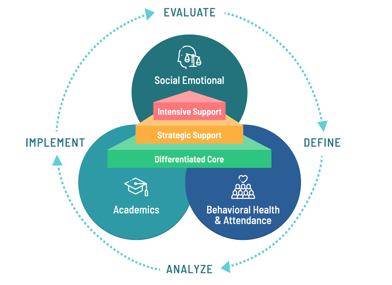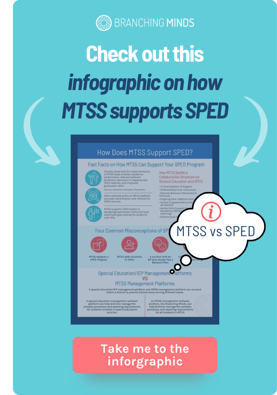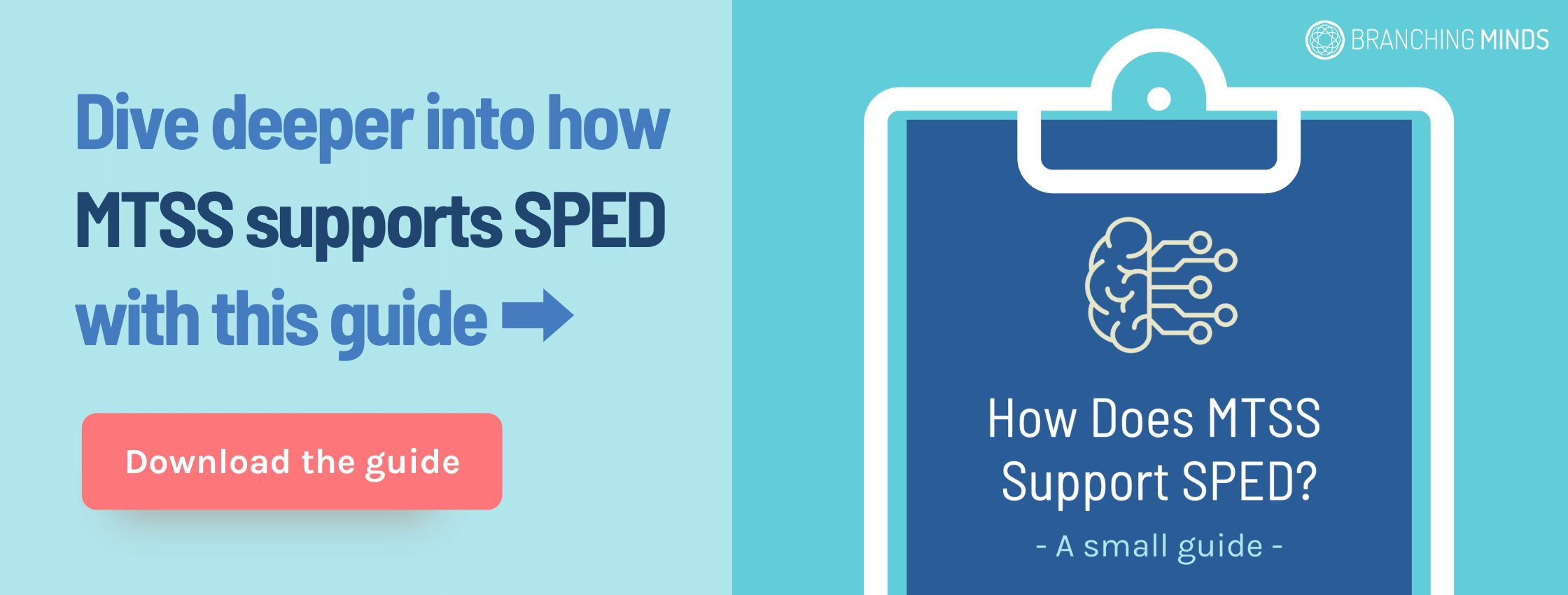“Around 15 percent of the world’s population, or an estimated 1 billion people, live with disabilities. They are the world’s largest minority.”
- United Nations’ Department of Economic and Social Affairs
NAVIGATE THIS ARTICLE:
-
What Are the Similarities Between MTSS and Special Education?
-
How Does an MTSS Management Platform Differ from a Special Education/IEP Management Platform?
- BONUS GUIDE - How Does MTSS Support SPED?
Special education and MTSS both provide support for students, but they have distinct "lanes." Both are designed to help learners succeed in school, but MTSS is a system of support for all students, while special education services are reserved for students with disabilities who need specially-designed instruction. Special education involves an extensive framework of resources, laws, specialized services, and staff designed to support the education of millions of students identified with a qualifying disability.
But this doesn't mean the two exist independently of one another! MTSS is designed to meet the needs of all students. The essential components built into a system of MTSS are created to help all learners access grade-level content, receive timely intervention, and guide educators in data-driven decision-making. Students with disabilities and learning challenges especially benefit from a robust Multi-Tiered System of Support. Let’s dive a bit deeper.
What Is MTSS?
In Branching Mind’s ultimate guide to MTSS, MTSS is defined as “a collaborative, evidence-based, approach to differentiating and personalizing instruction and intervention, across academics, social-emotional learning and behavior for all students—so that every student can achieve academic and life success.”
 The inclusion of a robust Multi-Tiered System of Supports (MTSS) framework within a school setting can aid in a district’s endeavor to provide an equitable education for all students, including students with disabilities.
The inclusion of a robust Multi-Tiered System of Supports (MTSS) framework within a school setting can aid in a district’s endeavor to provide an equitable education for all students, including students with disabilities.
This cycle is based upon supports, ranging from evidence-based interventions, instructional tools/strategies, MTSS staff, and data collection tools. Built upon a problem-solving process, MTSS provides a learning environment that prioritizes inclusion, prevention, intervention, and systematic data analysis. This system supports all areas of a student’s well-being: academic, behavioral, and social-emotional needs.
What Is Special Education (SPED)?
Special education is how students with disabilities receive specialized support. Federal and state laws protect students with disabilities, and ensure that these students receive a free and appropriate public education that targets their needs. One example of these laws is the Individuals with Disabilities Act (IDEA). To learn more about this law and how it provides specialized services for eligible students, check out the Department of Education’s IDEA website.
Special Education & Individualized Education Plans (IEPs)
In practice, SPED programs ensure that students with disabilities are identified, evaluated, supported, and provided access to free, public education. One of the structures in place to provide this support includes creating an individualized education plan (IEP) to assist in a student’s learning.
The IEP is a written plan that describes the individual learning needs of a student with disabilities and the SPED services, supports, aids, accommodations, and modifications that will be provided to that student. This legal document sets goals and standards for monitoring these goals and student progress.
An IEP follows a student, even if that student changes districts, and is consistently updated to reflect the most current data available. While you can dive much deeper into this topic, this provides a brief understanding of these three frameworks of support.
What Are the Similarities Between MTSS and Special Education?
MTSS and special education both have:
-
Progress-focused goal setting
Under MTSS, skill deficits or skill needs are identified in students through the use of universal screening assessment data and provided targeted intervention and resources with Tier 2 and Tier 3. All students, including students with disabilities, receive support through this identification process by utilizing universal screening data, tiered resources, and interventions. With special education, students eligible for special education receive targeted and individualized support and resources.
-
Individualized plans based on students' needs
Students receiving Tier 2 and Tier 3 support in MTSS receive an intervention plan. Students receiving special education services will have an accompanying IEP, with identified goals.
-
A strong foundation in collaboration and teamwork
An MTSS team includes an administrator, a facilitator, a content representative, a specialist, and a classroom teacher. In special education, the team often includes a special education teacher, a general education teacher, a speech-language pathologist, an occupational therapist, a social worker, and a nurse. Both depend on the collaboration and teamwork of skilled professionals to provide targeted services and support for struggling students.
How MTSS Supports All Students – Including Students Receiving Specialized Services Through Special Education
MTSS helps us understand if our core instruction is meeting the needs of most of our students. MTSS helps us see which of our students need a little extra support and who may need a lot of help.
At the foundation, general education should always provide strong, differentiated core instruction at the Tier 1 level to allow 100% of students access to grade-level instruction, which MTSS uses as its core. Tier 1 is provided for all students, all the time.
Universal screening assessments and diagnostic data provide insights into current students' needs and skill gaps. This data then directs the amount of scaffolding provided at the core instructional level and identifies students who need additional instruction and intervention to master the content.

MTSS Works in Conjunction With Special Education
MTSS is a timely and continuous process of identification, intervention, and analysis that can work in conjunction with special education programs and services. While students with disabilities continue to receive targeted services through a SPED program, these students also receive targeted resources and instruction with the system of MTSS.
In addition, MTSS data that’s used to improve the effectiveness of a student's instruction/intervention may also be used as part of the evaluation procedure for a special education referral (depending on the legal requirements related to special education referrals).
Tech Question: How Does an MTSS Management Platform Differ from a Special Education/IEP Management Platform?
An MTSS Management Platform and a Special Education Management System serve different purposes and co-exist within a district.
MTSS Platform
An MTSS Management Platform, such as Branching Minds, is utilized to help districts manage intervention planning, delivery, and reporting requirements for all students. For example, Branching Minds helps districts to:
- Utilize screening and assessment data to identify student needs
- Distill observations into individual student earning profiles, with strengths and challenges
- Locate appropriate evidence-based interventions
- Manage team alerts and tasks related to student intervention
- Create and monitor intervention delivery and plan fidelity
- Record MTSS meetings
- Assess MTSS system health and fidelity
- Generate intervention reports
- Communicate with families
All students, including those with Special Education services, are included in an MTSS Platform.
| The Branching Minds platform makes it easy to see students' tiered levels of need, special education services, and enrichment supports at a glance, along with plan status and activity. 504, IEP, behavior intervention plans, enrichment plans, and testing accommodations can be attached to student learning profiles in Branching Minds, providing each student's teacher access to the information they need to support that student. |
|
|
Special Education Platform
In contrast, a Special Education/IEP management system is designed to manage the special education referral and evaluation process, and then to draft, revise, and distribute IEPs and Section 504 Accommodation Plans.
Services of these systems include:
- Documenting and managing special education referrals
- Planning and evaluating special education services
- Generating IEP letters
- Scheduling meetings related to special education services or Section 504 plans
- Demonstrating compliance with state and federal regulations
- Generating alerts and notifications for key events and due dates
- Customizing workflows to manage special education processes
Only students identified for 504 and Special Education plans are included in a Special Education Platform.
So, Why MTSS? What Is the Purpose of MTSS?
MTSS is for all students, including students who have an IEP. While students with disabilities continue to receive support through special education services, MTSS provides support to all students in academic, behavioral, and social-emotional skill areas. A student with an IEP has access to tiered interventions and resources to support their access to grade-level content.
Universal screening assessment data is utilized to identify all students who need support and intervention. But an IEP does not automatically incidicate that a student with an IEP needs Tier 2 or Tier 3 support.
While a Special Education/IEP management system can help monitor progress and data for a specific topic a student has an IEP in, that student could also need support in other topics, which may not be represented in a special education system.
MTSS Provides Continuity of Support
MTSS is helpful for continuity of support and ensuring that students who need access to interventions have ready access. MTSS is the opposite of "wait to fail!" When providing holistic support to students and bringing Special Education students closer to the classroom, it helps to have a platform like Branching Minds that supports an "all students may be in need of support" mindset.
|
Key takeaways from this article:
|
References:
About IDEA. (n.d.). US Department of Education Individuals with Disabilities Act. Retrieved April 21, 2022
Cunningham, B. (n.d.). What is the difference between RTI and MTSS? Understood. Retrieved April 21, 2022, from https://www.understood.org/en/articles/whats-the-difference-between-rti-and-mtss
Farkas, G. (2020, February). Achievement gaps and multi-tiered system of supports in California. Policy Analysis for California Education. https://files.eric.ed.gov/fulltext/ED605086.pdf
Lee, A. (n.d.). The 13 disability categories under IDEA. Understood. Retrieved April 21, 2022, from https://www.understood.org/en/articles/conditions-covered-under-idea
Richards, C., Pavri, S., Golez, F., Canges, R., & Murphy, J. (2007). Response to intervention: Building the capacity of teachers to serve students with learning difficulties. Issues in Teacher Education, 16(2).
![[Guest Author] Laura Reber-avatar](https://www.branchingminds.com/hs-fs/hubfs/Graphics%20for%20blog%20content%20and%20promotion/laura-reber-headshot-cropped.png?width=82&height=82&name=laura-reber-headshot-cropped.png)
About the author
[Guest Author] Laura Reber
Laura Reber is a school psychologist who graduated valedictorian from Truman State University before completing her graduate degree in School Psychology from Illinois State University. She has worked as a school psychologist for over a decade, leading special education and MTSS teams. She also founded a tutoring company that has provided high-quality interventions to hundreds of students with a variety of academic needs. She serves Branching Minds as a consultant bringing together her knowledge of special education, MTSS, and effective academic and behavioral interventions. She loves to work with schools across the nation to implement effective MTSS systems because she has seen the power of MTSS in improving outcomes for students and schools!

Your MTSS Transformation Starts Here
Enhance your MTSS process. Book a Branching Minds demo today.














.png?width=504&height=312&name=Macbook_StudentList_Behavior%20(2).png)



.png?width=716&height=522&name=Addressing%20Foundational%20Reading%20Skills%20in%20MTSS%20(preview).png)
.png?width=716&height=522&name=Understanding%20Literacy%20Basics%20(Preview).png)
.png?width=716&height=522&name=Behavior%20Progress%20Monitoring%20(Preview).png)